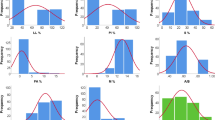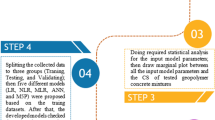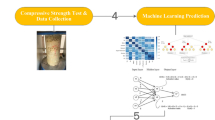Abstract
In the recent past, the developments in alkali-activated concrete have proven their suitability as an effective-emerging alternative sustainable concrete to restrain environmental concerns associated with Portland cement-based concrete constructions. In the area of pavement engineering, alkali-activated concrete is relatively unexplored. In contrast, alkali-activated concrete is relatively new compared to other fields of the construction industry. Extensive research has been conducted to discover diverse formulations under the scope of alkali-activated rigid pavement technology. But, forecasting the engineering properties such as concretes using traditional experimental and numerical techniques is still hindered by unsuitability and incertitude. To overcome such drawbacks, in the present study, an attempt was made to apply machine learning (ML) algorithms to obtain the best choice of different ingredients for finding the desirable basic mechanical properties [i.e. compressive strength (fc), split-tensile strength (ft) and flexural strength (ff)] of green alkali-activated pavement quality concretes (PQC). The regression techniques proposed include simple linear regression polynomial regression, decision tree regression, random forest regression, Bayesian ridge regression, ridge regressor, lasso regressor and elastic net regressor. The proposed work also implemented artificial neural network (ANN)-based regression analysis. The proposed work applies various ML algorithms to the given data set with 252 mix design records. It predicts the target variables, prepared and tested as per relevant Indian standards and codes of practice. The ML results reveal that the users can successfully analyse the fc, ft, and ff of green concretes without conducting laboratory experiments at a much more accurate level. For green concretes, such work is limited in scope; the result of this research proposes ML techniques to make the optimum utilization of industrial waste binders in producing alkali-activated PQC mixes through reduced manual labour efforts and conserve precious time spent otherwise in the testing laboratories.

































Similar content being viewed by others
Data availability
Data will be made available by the corresponding authors upon valid request.
References
Abdallah, M., Abu Talib, M., Feroz, S., Nasir, Q., Abdalla, H., & Mahfood, B. (2020). Artificial intelligence applications in solid waste management: A systematic research review. Waste Management, 109, 231–246. https://doi.org/10.1016/j.wasman.2020.04.057
Andrew, R. M. (2018). Global CO2 emissions from cement production, 1928–2017. Earth System Science Data, 10(4), 2213–2239. https://doi.org/10.5194/essd-10-2213-2018
Bishop, C. (2006). Pattern recognition and machine learning (1st ed.). Springer.
Chin, J., Callaghan, V., & Ben Allouch, S. (2019). The Internet-of-Things: Reflections on the past, present and future from a user-centered and smart environment perspective. Journal of Ambient Intelligence and Smart Environments, 11(1), 45–69. https://doi.org/10.3233/AIS-180506
Choudhary, A., Prakash, A., Rajasvaran, A., Bhuvan, L., & Editors, U. (n.d.). In Lecture Notes in Electrical Engineering 778 Applications of Artificial Intelligence and Machine Learning Select Proceedings of ICAAAIML 2020. http://www.springer.com/series/7818.
Deng, F., He, Y., Zhou, S., Yu, Y., Cheng, H., & Wu, X. (2018). Compressive strength prediction of recycled concrete based on deep learning. Construction and Building Materials, 175, 562–569. https://doi.org/10.1016/j.conbuildmat.2018.04.169
Du, H., & Tan, K. H. (2014). Waste glass powder as cement replacement in concrete waste glass powder as cement replacement in concrete. Journal of Advanced Concrete Technology, 12(11), 468–477. https://doi.org/10.3151/jact.12.468
ErkinayOzdemir, M., Ali, Z., Subeshan, B., & Asmatulu, E. (2021). Applying machine learning approach in recycling. Journal of Material Cycles and Waste Management, 23(3), 855–871. https://doi.org/10.1007/s10163-021-01182-y
Graus, M., Niemietz, P., Rahman, M. T., Hiller, M., & Pahlenkemper, M. (2018). Machine learning approach to integrate waste management companies in micro grids. In 2018 19th International Scientific Conference on Electric Power Engineering, EPE 2018 - Proceedings, IEEE, pp. 1–6. https://doi.org/10.1109/EPE.2018.8396029.
IRC:44. (2017). Guidelines for cement concrete mix design for pavements (pp. 1–60). Indian Road Congress.
IS 2386(Part IV). (1963P). Methods of test for aggregates for concrete—Mechanical properties (pp. 1–28). Bureau of Indian Standards.
IS 516. (1959). Indian standard methods of tests—For strength of concrete (1st ed.). Bureau of Indian Standards.
IS 5816-1999. (1999). Splitting tensile strength of concrete—Method of test (first revision). Bureau of Indian Standards.
IS:2386(Part III). (1963P). Method of test for aggregate for concrete (pp. 1–17). Bureau of Indian Standards.
IS:383. (2016). Coarse and fine aggregate for concrete— Pecification (pp. 1–21). Bureau of Indian Standards.
IS:456. (2000). Plain and reinforced concrete—Code of practice (pp. 1–100). Bureau of Indian Standards.
IS-2386:Part-I. (1963). Indian standard method of test for aggregate for concrete; Part I—Particle size and shape (pp. 1–26). Bureau of Indian Standards.
Jain, A., & Marathe, S. (2023). Soft computing modeling on air-cured slag-fly ash-glass powder-based alkali activated masonry elements developed using different industrial waste aggregates. Asian Journal of Civil Engineering, 1–13. https://doi.org/10.1007/s42107-023-00584-7.
Kandiri, A., MohammadiGolafshani, E., & Behnood, A. (2020). Estimation of the compressive strength of concretes containing ground granulated blast furnace slag using hybridized multi-objective ANN and salp swarm algorithm. Construction and Building Materials, 248, 118676. https://doi.org/10.1016/j.conbuildmat.2020.118676
Kaveh, A., & Khalegi, A. (1998). Prediction of strength for concrete specimens using artificial neural networks. Advances in Engineering Computational Technology.
Kaveh, A., & Khalegi, H. A. (2000). Prediction of strength for concrete specimens using artificial neural network. Asian Journal of Civil Engineering, 2(2), 1–13.
Kaveh, A., & Iranmanesh, A. (1998). Comparative study of backpropagation and improved counterpropagation neural nets in structural analysis and optimization. International Journal of Space Structures, 13(4), 177–185.
Kaveh, A., & Servati, H. (n.d.). Design of double layer grids using backpropagation neural networks. www.elsevier.com/locate/compstruc
Kaveh, A., Gholipour, Y., & Rahami, H. (n.d.). Optimal design of transmission towers using genetic algorithm and neural networks.
Kubat, M. (2017). An introduction to machine learning (2nd ed.). Springer International Publishing AG. 10.1007/978-3-319-63913-0.
Marathe, S., Mithanthaya, I. R., Mithun, B. M., Shetty, S., & Akarsh, P. K. (2020). Performance of slag-fly ash based alkali activated concrete for paver applications utilizing powdered waste glass as a binding ingredient. International Journal of Pavement Research and Technology. https://doi.org/10.1007/s42947-020-0173-2
Marathe, S., Mithanthaya, I. R., & Shenoy, R. Y. (2021). Durability and microstructure studies on Slag-Fly Ash-Glass powder based alkali activated pavement quality concrete mixes. Construction and Building Materials, 287(123047), 1–19. https://doi.org/10.1016/j.conbuildmat.2021.123047
Marathe, S., Mithanthaya, I. R., & Shetty, S. S. (2019). Research on eco-friendly alkali activated concrete incorporating industrial wastes. International Journal of Innovative Technology and Exploring Engineering. https://doi.org/10.35940/ijitee.I1101.0789S219
Mitchell, T. M. (2017). Machine learning (1st ed.). New Delhi: McGraw Hill Education (India) Private Limited.
Mithanthaya, I. R., & Rao, N. B. S. (2015). Effect of glass powder and GGBS on strength of Fly Ash based geopolymer concrete. International Journal of Engineering Trends and Technology, 19(2), 66–71.
Mithun, B. M., & Narasimhan, M. C. (2015). Performance of alkali activated slag concrete mixes incorporating copper slag as fine aggregate. Journal of Cleaner Production, 112, 837–844. https://doi.org/10.1016/j.jclepro.2015.06.026
Mukherjee, S. (2020). Emerging frontiers in smart environment and healthcare—A vision. Information Systems Frontiers, 22(1), 23–27. https://doi.org/10.1007/s10796-019-09965-3
Nagalli, A. (2021). Estimation of construction waste generation using machine learning. Proceedings of Institution of Civil Engineers: Waste and Resource Management, 174(1), 22–31. https://doi.org/10.1680/jwarm.20.00019
Pacheco-Torgal, F., Castro-Gomes, J., & Jalali, S. (2008). Alkali-activated binders: A review. Construction and Building Materials, 22(7), 1305–1314. https://doi.org/10.1016/j.conbuildmat.2007.10.015
Palankar, N., Shankar, A. U. R., & Mithun, B. M. (2015a). Air-cured alkali activated binders for concrete pavements air-cured alkali activated binders for concrete pavements. International Journal of Pavement Research and Technology, 8(July), 289–294. https://doi.org/10.6135/ijprt.org.tw/2015.8(4).289
Palankar, N., Shankar, A. U. R., & Mithun, B. M. (2015b). Investigations on alkali-activated slag/fly ash concrete with steel slag coarse aggregate for pavement structures. International Journal of Pavement Engineering, 8436(10), 1–13. https://doi.org/10.1080/10298436.2015.1095902
Part, W. K., Ramli, M., & Cheah, C. B. (2015). An overview on the influence of various factors on the properties of geopolymer concrete derived from industrial by-products. Construction and Building Materials, 77, 370–395. https://doi.org/10.1016/j.conbuildmat.2014.12.065
Provis, J. L., Palomo, A., & Shi, C. (2015). Advances in understanding alkali-activated materials. Cement and Concrete Research, 78, 110–125. https://doi.org/10.1016/j.cemconres.2015.04.013
Reddy, N.B., Kuntoji, G., Rao, S., Manu, & Mandal, S. (2016). Prediction of wave transmission using ANN for submerged reef of tandem breakwater. In International Conference on Emerging Trends in Engineering and Technology, pp. 137–142.
Shahmansouri, A. A., AkbarzadehBengar, H., & Ghanbari, S. (2020). Compressive strength prediction of eco-efficient GGBS-based geopolymer concrete using GEP method. Journal of Building Engineering, 31(101326), 1–11. https://doi.org/10.1016/j.jobe.2020.101326
Shaikh, F., Kazi, N., Khan, F., & Thakur, Z. (2020). Waste profiling and analysis using machine learning. Second International Conference on Inventive Research in Computing Applications, ICIRCA, 2020, 488–492. https://doi.org/10.1109/ICIRCA48905.2020.9183035
Shayan, A., & Xu, A. (2003). Value-added utilisation of waste glass in concrete. Cement and Concrete Research, 34(1), 81–89. https://doi.org/10.1016/S0008-8846(03)00251-5
Singh, B., Ishwarya, G., Gupta, M., & Bhattacharyya, S. K. (2015). Geopolymer concrete: A review of some recent developments. Construction and Building Materials, 85, 78–90. https://doi.org/10.1016/j.conbuildmat.2015.03.036
Toniolo, N., & Boccaccini, A. R. (2017). Fly ash-based geopolymers containing added silicate waste. A review. Ceramics International, 43(17), 14545–14551. https://doi.org/10.1016/j.ceramint.2017.07.221
Ullah, Z., Al-Turjman, F., Mostarda, L., & Gagliardi, R. (2020). Applications of artificial intelligence and machine learning in smart cities. Computer Communications, 154(December), 313–323. https://doi.org/10.1016/j.comcom.2020.02.069
Yang, J., Xiao, W., Jiang, C., Hossain, M. S., Muhammad, G., & Amin, S. U. (2019). AI-powered green cloud and data center. IEEE Access, 7, 4195–4203. https://doi.org/10.1109/ACCESS.2018.2888976
Zhang, L. V., Marani, A., & Nehdi, M. L. (2022). Chemistry-informed machine learning prediction of compressive strength for alkali-activated materials. Construction and Building Materials, 316(December 2021), 126103. https://doi.org/10.1016/j.conbuildmat.2021.126103
Funding
The author(s) received no specific funding for this study.
Author information
Authors and Affiliations
Contributions
Dr. Roshan Fernandes, Dr. Anisha P Rodrigues: Supervision, Methodology, Visualization, Conceptualization. Dr. Shriram Marathe, Ms. Akhila S: Writing- Original draft preparation, Investigation, Review, Resources, Data accusation, Formal analysis. Dr. Łukasz Sadowski: Reviewing and Editing, Validation.
Corresponding author
Ethics declarations
Conflict of interest
The authors declare that they have no conflicts of interest to report regarding the present study.
Additional information
Publisher's Note
Springer Nature remains neutral with regard to jurisdictional claims in published maps and institutional affiliations.
Rights and permissions
Springer Nature or its licensor (e.g. a society or other partner) holds exclusive rights to this article under a publishing agreement with the author(s) or other rightsholder(s); author self-archiving of the accepted manuscript version of this article is solely governed by the terms of such publishing agreement and applicable law.
About this article
Cite this article
Fernandes, R., Marathe, S., Rodrigues, A.P. et al. Smart modelling system for alkali-activated concrete pavements using machine learning techniques. Asian J Civ Eng 24, 2193–2213 (2023). https://doi.org/10.1007/s42107-023-00635-z
Received:
Accepted:
Published:
Issue Date:
DOI: https://doi.org/10.1007/s42107-023-00635-z




